On May 1st, the Philippine Coast Guard (PCG) announced they would dispatch a vessel to intercept the Chinese research vessel, the Shen Kuo, currently loitering about 30 miles (48 km) east of the coast of Samar Island in the eastern Philippines. The Armed Forces of the Philippines (AFP) reported the vessel was first sighted on April 25th, approximately 70 miles (113 km) east of Rapu-Rapu Island, Albay province.
Intercept of the Vessel
The Philippine Air Force’s Tactical Operations Wing Southern Luzon (TOWSOL) dispatched a NC-212i turboprop aircraft to intercept and monitor the research vessel on April 27th. The aircraft’s crew took several photographs and videos as it flew around the vessel during the mission. The aircrew attempted to contact the vessel through various radio channels but received no response, which may indicate “a lack of responsiveness or willingness to engage.” Furthermore, they also said the vessel was loitering in the area, and they did not see any personnel on the deck. The aircrew said that they did not see any signs that the ship was in distress or had any mechanical issues. The TOWSOL statement said that the AFP also tasked nearby vessels to surveil and report on the vessel’s activities.
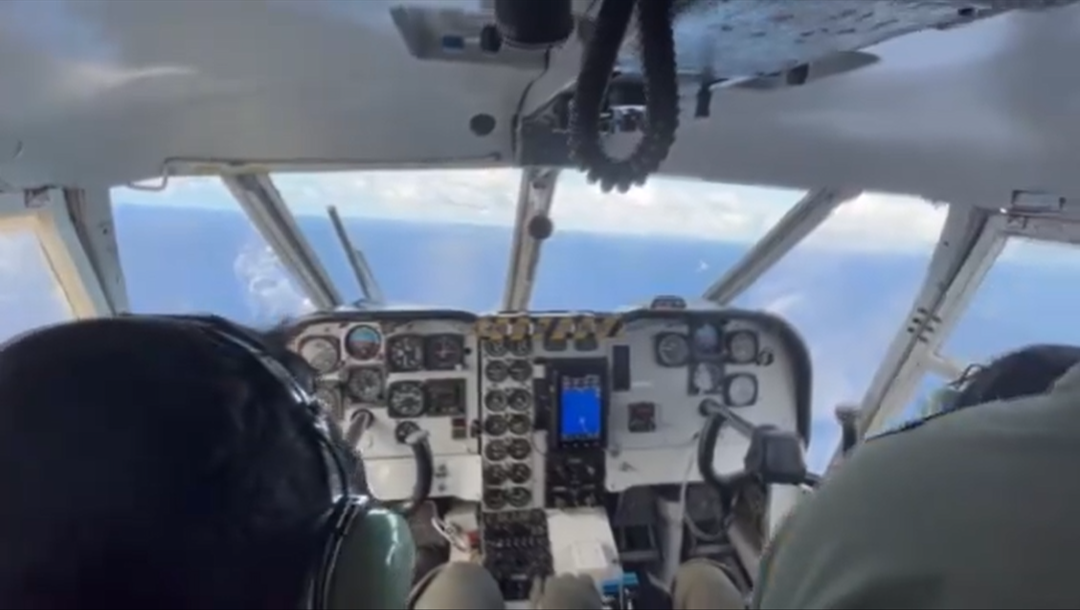
Navy spokesperson for the West Philippine Sea, Commodore Roy Vincent Trinidad, also commented about the Shen Kuo during the daily AFP press conference. Trinidad said that the vessel’s “erratic behavior or their erratic track is indicative of conducting studies or possibly maritime research for whatever reason.” He also emphasized that the PAF has an image of the vessel “lowering an unidentified [piece of] equipment, probably for scientific research or studies.” However, Trinidad said that the Philippine military is still in the process of identifying the equipment the aircrew photographed. The Commodore also confirmed that the AFP is working closely with the PCG to send a vessel to intercept the Chinese research vessel. However, the PCG is “looking for the most favorable time before it could send out a ship,” according to Trinidad.
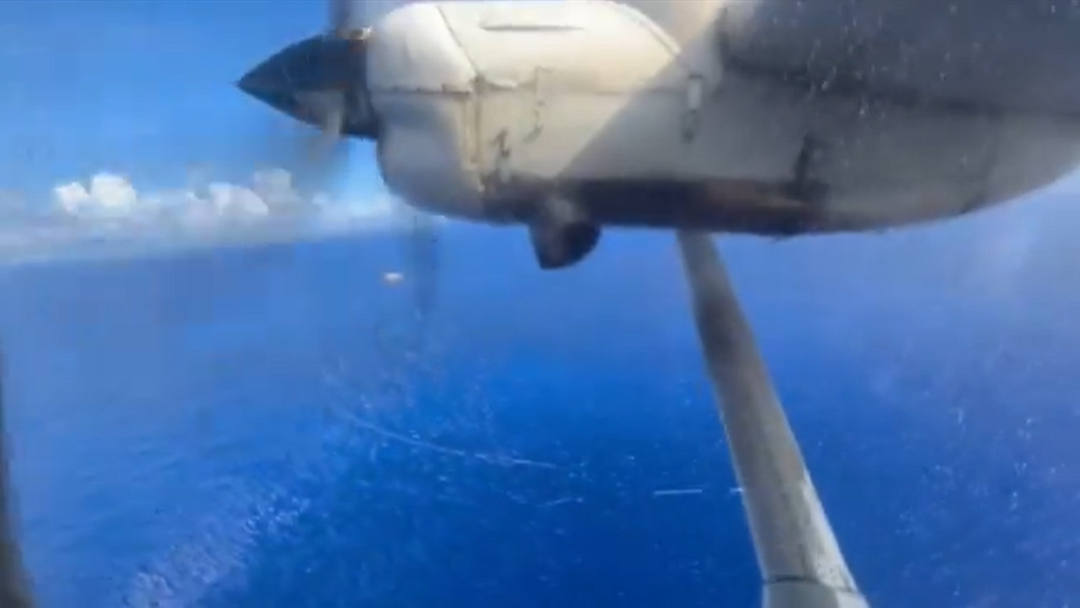
The PCG Spokesperson for the South China Sea (SCS), Commodore Jay Tarriela, said the organization is waiting for a vessel to become available so it can monitor the Shen Kuo on May 1st. Tarriela said that currently, the PCG’s limited number of vessels are strategically located on the Philippines’ western coast. Furthermore, he said that if there is an “available vessel that we can deploy, we will be deploying it to check on the Chinese survey ship” in the Brenham (Philippine) Rise. However, he said that the PCG still has different ways for us to monitor the activity of the Chinese research vessel, even if the organization can’t send a ship.
Voyage to and Movements Near the Philippines
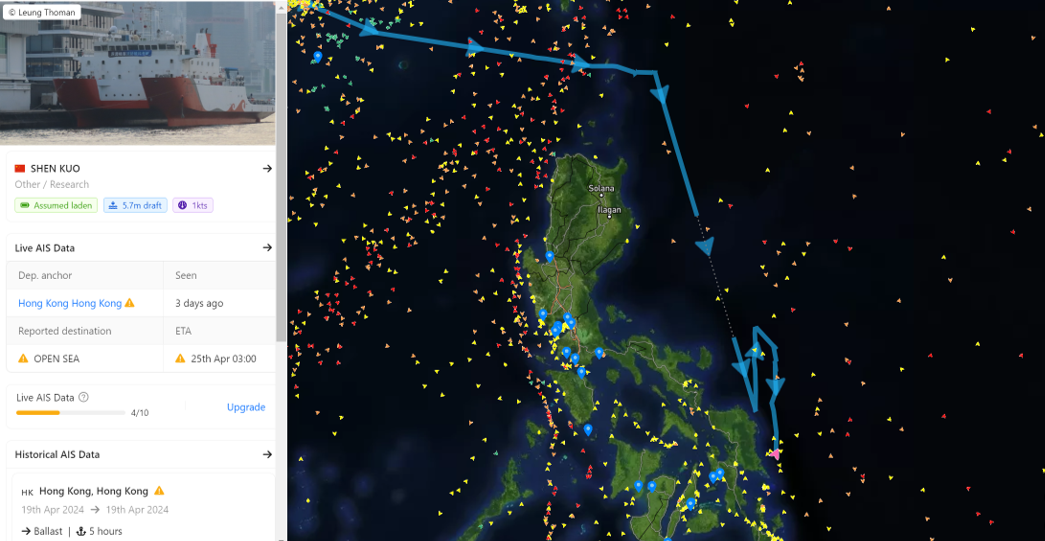
The vessel departed Hong Kong on April 19th and traveled through the Luzon Strait between April 21st and 22nd. The Shen Kuo then turned and traveled south entering the Philippines’ Economy Exclusive Zone (EEZ) on April 24th. However, the research ship then sailed deeper into the country’s EEZ near the town of Viga, Catanduanes Province, on April 25th. The vessel continued south, nearing the northeastern coast of Samar Island. On April 26th, Shen Kuo turned and sailed north before turning to the southeast and then sailing south. The vessel then re-entered the Philippines’ EEZ on April 27th, near Samar, and loitered in the area. The Shen Kuo then proceeded to sail down Samar Island’s coast. Between April 28th and May 1st, the Shen Kuo intermittently loitered approximately 35 miles (56 km) east of Samar in the Benham (Philippine) Rise.
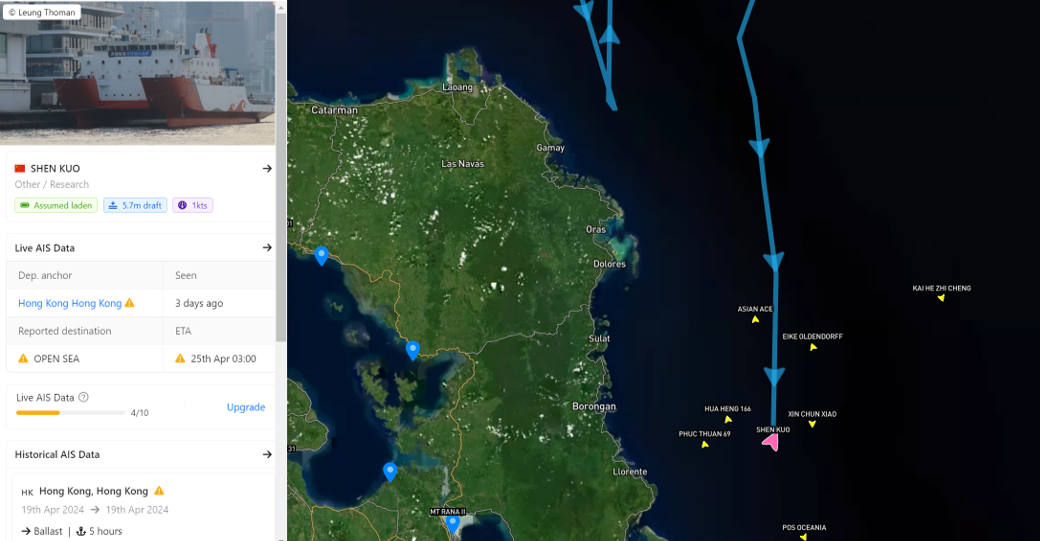
Shen Kuo and Rainbow Fish Marine Science & Technology Co.
The China Shipbuilding Industry Corporation’s 702 Research Institute designed the Shen Kuo in the early to mid-2010s. The Taihe Marine Science and Technology Group (TMSTG) invested and built in Shanghai. The TMSTG launched the research vessel in April 2018 and currently operates the Shen Kuo. However, the Shanghai-based company, Rainbow Fish Marine Science & Technology Co., also known as HadalX, owns the Shen Kuo. The research vessel is a small-waterline catamaran that is 207 feet (63 meters) long, has a beam of 75 feet (23 meters), and has a depth of 31 feet (9.4 meters). The vessel has a full-load displacement of approximately 2,194 tons and requires a crew of 60 to operate. The 702 Research Institute designed the vessel as a multifunctional, multi-technology deep and distant scientific research vessel that can conduct multidisciplinary cross-research in marine science. The vessel has the capability to carry, launch, and recover both manned and unmanned submersibles.
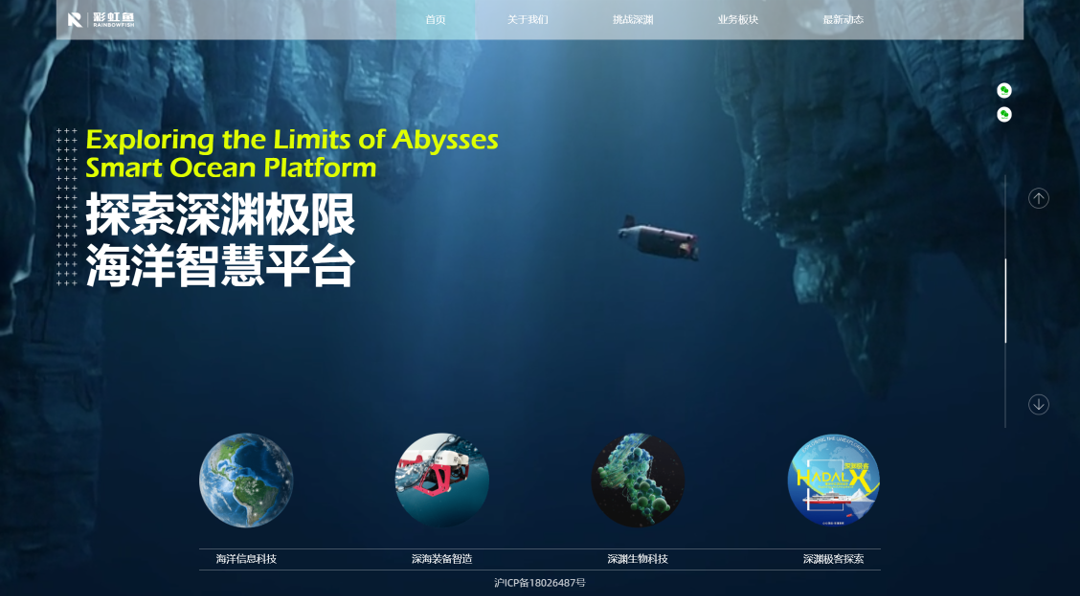
The Shanghai-based company, Rainbow Fish Marine Science & Technology Co., also known as Hadalx, owns the research vessel. Hadalx is the informal name for Deepsea Education Ocean Exploration Operation and Management Group Ltd., which is based in Hong Kong. Rainbow Fish Group’s headquarters is based in the Lingang Free Trade Zone New Area (LFTZNA), located in Shanghai’s Pudong section. The company is a marine high-tech company committed to using deepsea science and technology as an innovative, multi-disciplinary hand that expands to cover the whole sea area and depth. Furthermore, the company has four primary business segments: marine information science and technology, deepsea equipment research and development, deepsea biotechnology, and deepsea education and exploration. Rainbow Fish Group uses Hadalx to conduct activities related to its deepsea education and exploration segment.
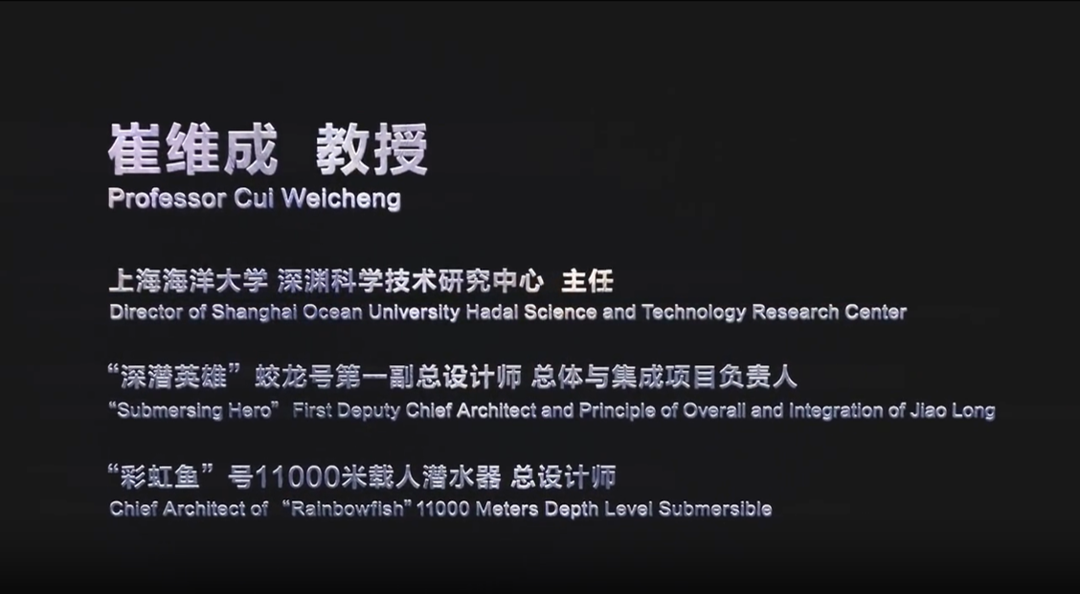
Cui Weicheng, director of the Shanghai Ocean University Deepsea Science and Technology Research Center, deputy commander of the Deepsea Dragon submersible, and a Chinese Communist Party (CCP) member, developed the initial idea for the business. Cui joined Shanghai Ocean University in 2013 to develop and build a submersible capable of diving to approximately 36,000 feet (11,000 meters) in depth. However, he did not have the necessary funds to begin the development, so the Shanghai government connected him with Wu Xin, a Shanghai-based businessman, in 2013. Wu founded both firms in 2014 and is currently the CEO of both companies. The company cooperates closely with Shanghai Ocean University’s Deepsea Science and Technology Research Center and other universities that specialize in oceanographic or ocean engineering research and development.

For example, the company and the research center are cooperating in developing the third generation manned submersible, the Rainbow Fish. Furthermore, Rainbow Fish Group uses Hadalx as another avenue to conduct research and hold events with universities in Hong Kong and China. The most recent example occurred in November 2023, when Hadalx and Yew Chung Yew Wah Education Network held an event in Hong Kong. Several professors and student delegations from high schools and universities attended and participated in the event. The exhibition included professors giving speeches, a Q&A session with Wu and Hong Kong Baptist University’s Associate Head of Department of Biology, Dr. Qiu Jianwen, and guided tours of the Shen Kuo and a Rainbow Deepflight manned submersible.
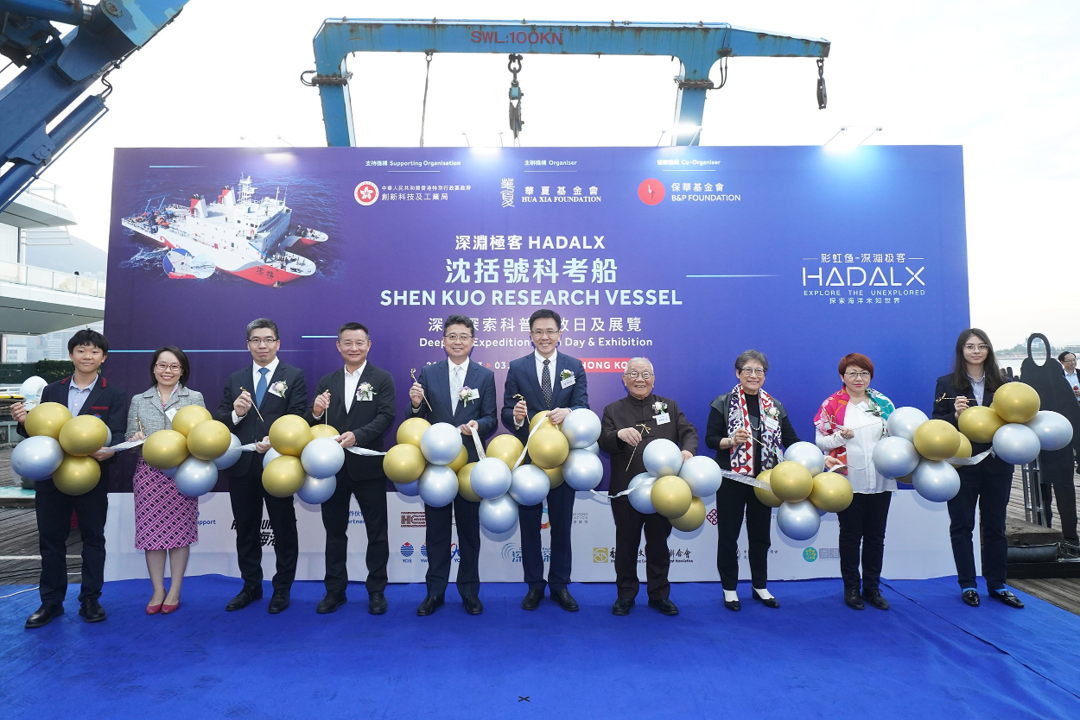
Analysis
The Shen Kuo’s continued presence in the Philippines’ EEZ indicates that China views the Philippine Rise as a permissive area to operate in and to counter the country’s SCS presence. Furthermore, Rainbow Fish Group also shows how China will use these deepsea exploration companies to both further its economic and maritime interests.
The Shen Kuo’s operations in the Philippines’ EEZ indicates that China views the Philippine Rise as a permissive area to operate in and to counter the country’s SCS presence. In late February, two Chinese research vessels sailed to the same area in the Philippine Sea and operated until the PCG detected the ships. The PCG then sent a vessel to monitor the Chinese ships until they left the area in early March. The vessels then left the area in early March. However, China judged that the PCG would lack vessels to respond to Shen Kuo’s intrusion due to supporting operations and patrols related to the SCS and the Balikatan exercise. Tarriela’s comments about the PCG’s inability to challenge the Chinese research vessel’s presence due to the lack of available ships give credence to this argument. Furthermore, Tarriela’s comments about the PCG having other ways to monitor the vessel also strengthen this argument, since they indicate that the organization lacks ships to deploy.
China also uses the research vessel operations to counter the Philippines’ SCS presence since it also forces the country to deploy vessels to patrol the Philippine Rise. The deployments would strain the Philippines’ ability to conduct maritime patrols in the SCS, especially at the Scarborough Shoal, Second Thomas Shoal, or other Philippine-occupied features. The Philippines would need to reposition vessels in areas along its eastern coast to conduct presence patrols to deter and monitor any Chinese vessels that operate in the area. However, the repositioning of PCG vessels would mean the organization would have fewer vessels to conduct operations in the SCS.
The Philippines will require the Bureau of Fisheries and Aquatic Resources (BFAR) vessels to assist in patrolling the Philippine Rise. The BFAR will face the same issue as the PCG, since they also have a heavy SCS presence and have deployed most of their vessels to the SCS. This dilemma would force the PCG to ask the Philippine Navy (PN) to assist in monitoring the Philippine Rise. While the PN could monitor the Philippines’ eastern coast, this option would allow China to use these patrols to push its narrative that the country is increasing tensions. Another option for the PCG is to increase the procurement of PCG vessels. The PCG’s new vessels would increase the number of ships available for patrols, but the quantity is too low to solve the issue.
The research vessel also illustrates how China will use deepsea exploration companies to advance its economic and maritime interests. The Shanghai municipal government provided a large amount of investment in Rainbow Fish Group as part of China’s ‘Made in China 2025’ program. Furthermore, Wu and Cui established the company through the ‘scientists + entrepreneurs’ initiative, which allowed scientists to receive investment if their ideas were prioritized by the ‘Made in China 2025 program. Rainbow Fish Group fell into the program’s ocean engineering and high-tech ship industry category, so it received prioritization for investment and other program incentives. For example, the company established its headquarters at the LFTZNA because the Shanghai government created the zone to support firms associated with the Made in China 2025 initiative. Furthermore, the Chinese government also uses the company to show that the initiative is successful and is allowing China to develop advanced technologies through domestic research and development efforts.
Furthermore, China also views companies such as Rainbow Fish Group as vital to advancing its maritime interests due to their ability to allow the country to access the deepsea environment. Rainbow Fish Group’s development and manufacture of manned and unmanned deepsea submersibles enables the company to support various scientific initiatives pushed by China. These initiatives include exploring the deepsea environment to locate components for use in cosmetics, medicines, and agriculture; equipment for deepsea exploration; and programs to increase maritime intelligence and knowledge. However, Shen Kuo’s deployment to the Philippine Rise was to conduct hydrologic surveys of the area.
The data gathered during the survey would have several uses such as gathering samples to locate and map mineral deposits and oil fields, and marine science. However, the People’s Liberation Army Navy (PLAN) can also use the maps developed by the survey to refine their hydrologic phones and sonar suites to operate more efficiently in the environment. Furthermore, the PLAN can also use the data to develop more detailed maps of the Philippine Rise so their submarines can operate more effectively in the area.

